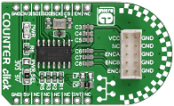|
|
| |
|
 | Search: |
|
|
 |

|
|
Rotary click carries a 15-pulse incremental rotary encoder with detents, surrounded by a ring of 16 green LEDs. It's a perfect solution for adding a precision input knob to your design. The encoder outputs A and B signals (out of phase to each other) on mikroBus PWM and AN lines; the knob also acts as a push-button which sends an interrupt to the target board MCU via the mikroBus INT line. The LED ring is controlled through SPI lines (CS, SCK, MISO, MOSI and RST). Rotary click can be used with either a 3.3V or 5V power supply. |
|
|
|
|
 |

|
|
Counter click carries an LS7366R 32-bit quadrature counter. The top of the board has a pinout for interfacing with incremental encoders. The interface has ENCA and ENCB pins, along with ENCI, which is a programmable index. The A and B pulses fron an encoder are out of phase to each other, ideally by 90°. The LS7366R CMOS counter takes these signals as inputs and decodes them for determining direction and speed. On the other side, Counter click communicates with the target board microcontroller through the mikroBUS SPI interface (CSK, MISO, MOSI), plus enable (CNT EN) and interrupt (LFLAG) pins. The board can use either a 3.3V or a 5V power supply. |
|
|
|
 |

|
|
Thumbwheel click is a mikroBUS add-on board with a 10-position rotary sprocket connected to a 1-Wire 8-Channel Addressable Switch. The starting position of the switch is marked with a small notch on the PCB above the wheel. Printed numerals from 1 to 10 clearly mark each position.
The thumbwheel has a crown with small incisions for better finger traction. The board can use both a 3.3V or a 5V power supply. The One-Wire signal can be sent either through the mikroBUS AN or PWM pins. You choose which one by soldering the GP SEL jumper into the right position. |
|
|
|
 |
|
|

